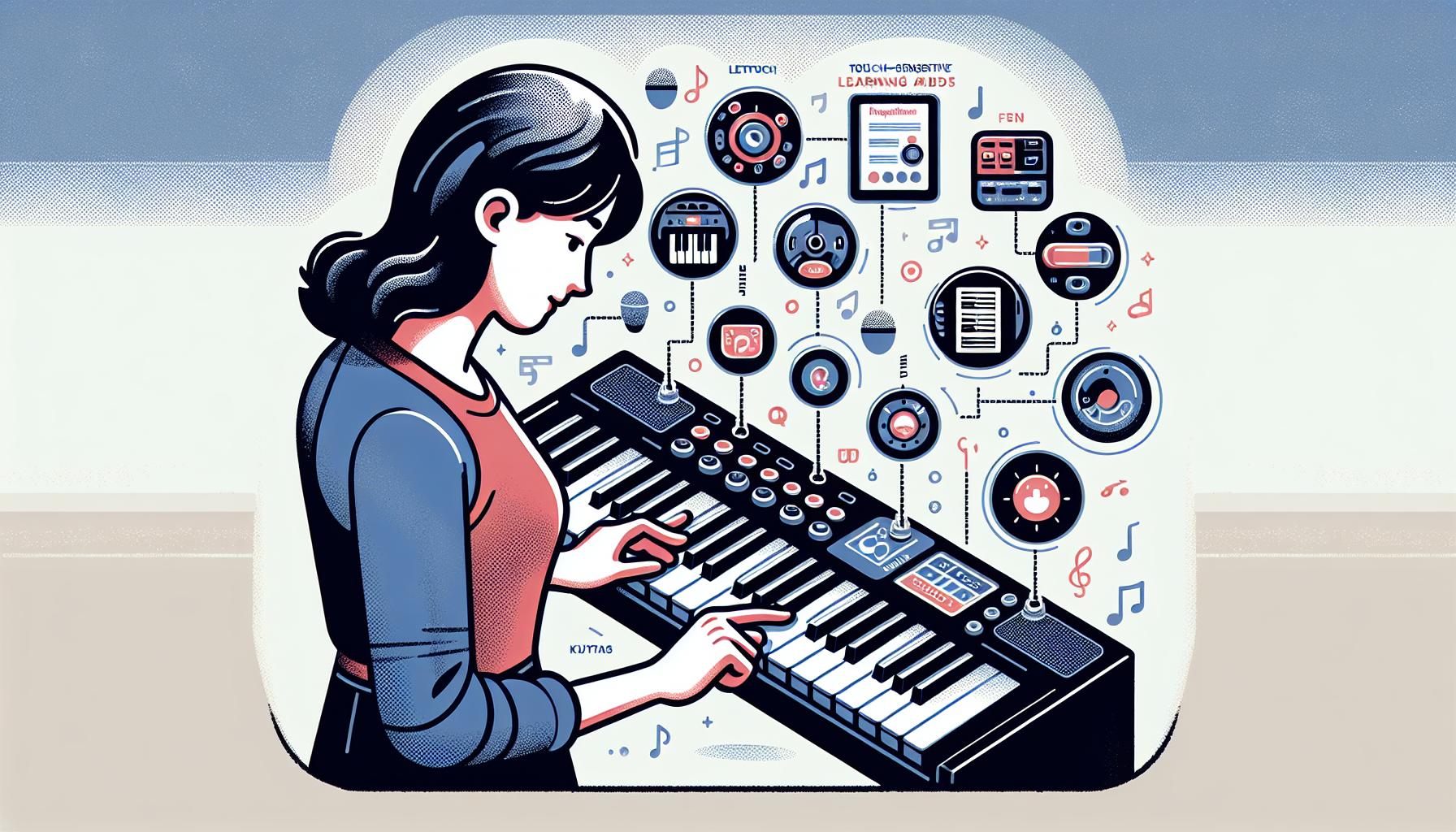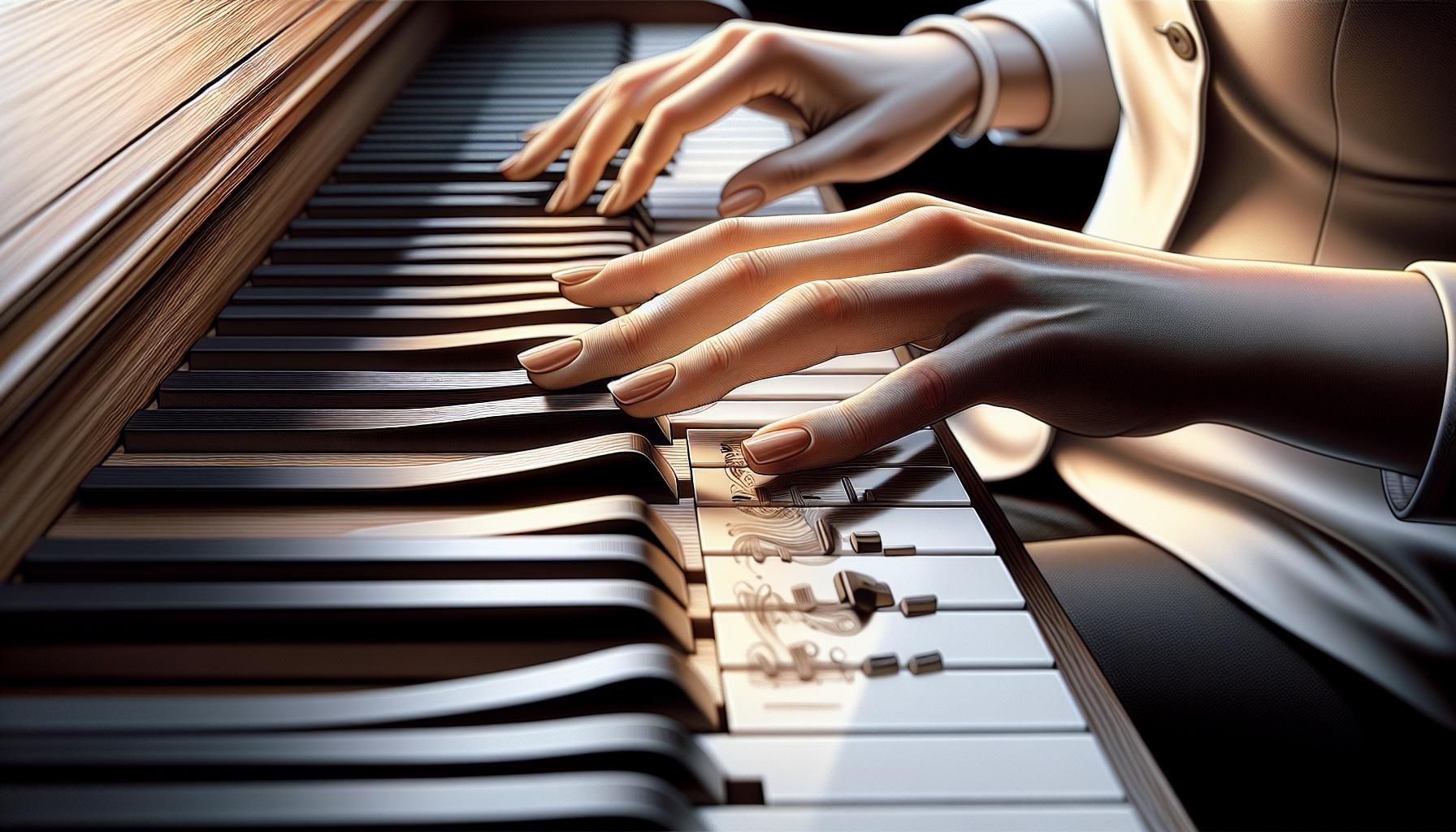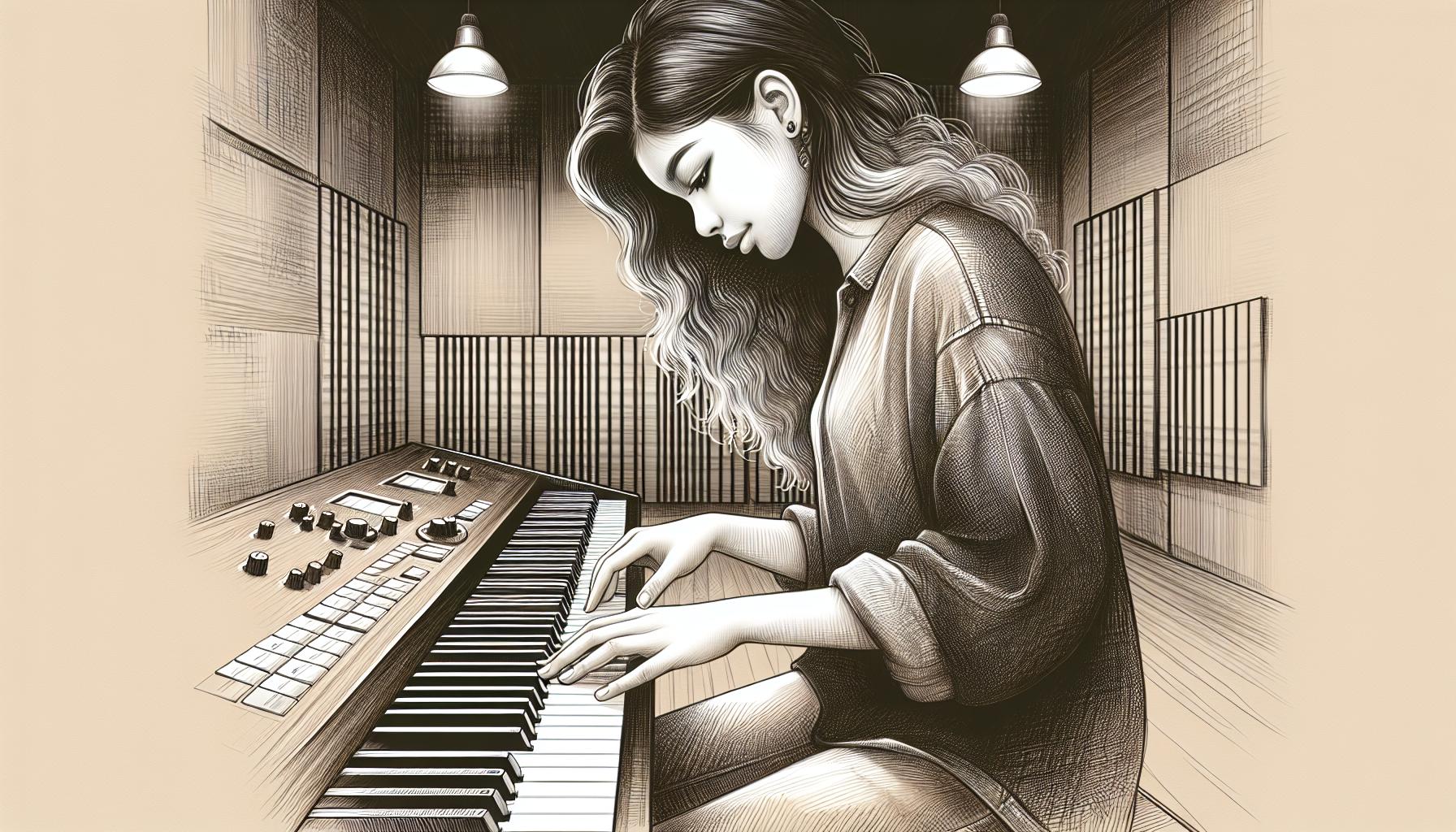Stepping into the world of music can be an exhilarating journey, especially when you're armed with the right instrument. For those beginning their musical voyage, a keyboard with touch-sensitive keys can be a game-changer. It's not just about pressing keys; it's about feeling the music flow through your fingertips, allowing for a more expressive and dynamic performance.
Touch-sensitive keyboards are designed to respond to the player's touch, offering a range of sounds that vary from soft to loud, depending on how hard the keys are pressed. This feature mimics the action of an acoustic piano, making it an ideal choice for beginners eager to learn and grow. It bridges the gap between novice and seasoned players, providing a platform to explore, experiment, and enhance musical skills.
Benefits of Touch-Sensitive Keys
Touch-sensitive keys on a keyboard recast a beginner's learning experience, transforming it from mere practice to an immersive journey of musical expression. They achieve this by offering a range of dynamics that mirror the human emotions - from the softest whisper of a ballad to the thundering climax of a symphony.
One of the core benefits of this technology is Enhanced Musical Expression. As beginners familiarize themselves with the keyboard, the touch-sensitive keys foster a deeper connection with the music. They learn the delicate art of dynamics, which is vital in conveying emotion through performance. This skill is not just about playing notes; it's about breathing life into them.
Another significant advantage is Improved Technique. Traditional, non-responsive keyboards do not provide feedback based on how hard or softly the keys are pressed, which can lead to a mechanical style of play. On the other hand, touch-sensitive keyboards challenge learners to refine their touch and control, contributing to a more polished and versatile technique. This is crucial for those progressing to more advanced pieces or instruments.
Moreover, these keyboards serve as a Bridge to Acoustic Pianos. The hallmark of an acoustic piano is its responsiveness to touch, allowing for a wide array of sound dynamics. By starting with a touch-sensitive keyboard, beginners can seamlessly transition to an acoustic piano, as they've already developed the sensitivity and dynamics required.
Importantly, touch-sensitive keys encourage Practice Consistency. When beginners feel the immediate feedback of their touch influencing the sound, it turns practice sessions into explorative and enjoyable experiences. This interaction not only makes practice sessions more enticing but also fosters a love for playing and learning music.
Lastly, Customization and Versatility stand out. Most touch-sensitive keyboards come with settings to adjust the sensitivity level. This feature allows beginners to tailor the keyboard's response to their current skill level, ensuring the instrument grows with them. Additionally, the inclusion of various instrument sounds and built-in metronomes or recording capabilities further enriches the learning experience, allowing for experimentation and diversity in practice.
In a Study on Music Education Techniques, researchers highlighted the significance of touch sensitivity in keyboards for effective learning:
| Factor | Percentage of Teachers Who Recommend |
|---|---|
| Enhanced Musical Expression | 85% |
| Improved Technique | 78% |
| Bridge to Acoustic Pianos | 90% |
Features to Look for in a Beginner Keyboard

When venturing into the vast world of music, finding the perfect beginner keyboard can seem like a daunting task. Yet, with the right features, newcomers can ensure they're on the path to musical discovery and growth. Among these features, touch-sensitive keys stand out for their crucial role in fostering expressive play and technique. However, to truly harness their musical potential, learners should look beyond touch sensitivity alone.
Range of Voices
A keyboard that offers a wide variety of instrument voices allows beginners to explore different musical styles and sounds. From the rich tones of a grand piano to the warm embrace of a string ensemble, having access to a diverse range of voices encourages creativity and keeps practice sessions engaging.
Built-in Learning Tools
With technology constantly evolving, many keyboards now come equipped with built-in learning tools designed to support beginners on their musical journey. These features may include:
- Step-by-step lessons to guide newcomers through the basics of playing
- Chord dictionaries that help in understanding and playing various chords
- Light-up keys that provide visual feedback on which notes to play
Such tools can make learning more interactive and fun, significantly enhancing the overall experience.
Connectivity Options
In an age where digital resources are at our fingertips, having a keyboard with connectivity options is a major plus. USB or MIDI ports allow for easy connection to computers and mobile devices, opening up a world of instructional software and apps. This connectivity not only facilitates access to additional learning materials but also enables beginners to record and share their progress.
Portability and Size
Especially for younger players or those with limited space, a keyboard's portability and size are important considerations. Keyboards that are lightweight and compact can easily be moved or stored, ensuring that practice can happen anywhere and at any time. For beginners, starting with a 61-key keyboard is often recommended as it provides enough range to learn and play most pieces without overwhelming the player.
Durability and Price
Lastly, it's important to balance between durability and price. Beginners need an instrument that can withstand the learning process but also doesn't break the bank. There are many affordable keyboards that offer a good quality experience without the high cost, making them great options for those just starting out.
Importance of Dynamic Range in Musical Expression

When embarking on the journey to learn piano on a beginner keyboard, one feature that stands apart in its capacity to elevate the learning experience is the dynamic range. This crucial aspect of keyboard playability relates directly to touch-sensitive keys, which account for the variation in sound volume and tone based on how hard or softly they are pressed. For learners, mastering the dynamic range not only adds depth and emotion to their playing but also lays down a solid foundation for advanced musical techniques.
Touch-sensitive keys enable players to experiment with nuances in musical expression. This means that a piece of music can convey a broad spectrum of emotions, from the delicate whispers of a pianissimo to the bold declaration of a fortissimo, all controlled by the pressure applied to the keys. This dynamic control is vital for beginners as it ingrains an understanding of musical texture and how different intensities can be used to tell a story or evoke specific feelings.
Moreover, playing on a keyboard that lacks touch sensitivity can be likened to speaking in a monotone voice—without the ability to emphasize certain words or modulate volume, the speech loses much of its impact and expressiveness. Similarly, music played without dynamic variation tends to sound flat and unengaging. Therefore, keyboards with touch-sensitive keys are not just a nice-to-have feature; they're essential for beginners aiming to develop a nuanced and expressive playing style.
The importance of dynamic range in musical expression also extends to the realm of practice and performance. For instance, when beginners work on pieces that require soft passages followed by sudden loud sections, they learn to control their finger strength and develop a tactile sensitivity that is crucial for playing more complex compositions. This control cannot be overstated, as it directly correlates with a musician's ability to convey emotion through their instrument.
Furthermore, the inclusion of touch-sensitive keys on beginner keyboards encourages experimentation with different musical styles, each with its own dynamic requirements. Jazz, classical, pop, and rock music all demand varying degrees of touch sensitivity, and having a keyboard that responds to these nuances ensures a more versatile and enriching learning experience.
| Feature | Impact on Learning Experience |
|---|---|
| Dynamic Range | Enhances musical expression and emotion |
| Touch Sensitivity | Encourages development of nuanced playing style |
| Versatility | Enables exploration of various musical genres |
Advantages of Mimicking Acoustic Piano Action

When embarking on the journey to learn the piano, many students start with a beginner keyboard due to its affordability and practicality. However, a keyboard that mimics the action of an acoustic piano, especially with touch-sensitive keys, can offer a more enriching and beneficial learning experience. This section highlights why keyboards with these characteristics are superior for novices.
Enhanced Learning Experience
Touch-sensitive keyboards simulate the weight and resistance found in acoustic piano keys. This feature is critical because it allows learners to develop a necessary sense of touch right from the start. Playing on a touch-sensitive keyboard means the volume and tone of the music change in response to how softly or forcefully the keys are pressed. This response closely mirrors the action of an acoustic piano, providing a Realistic Playing Experience that is essential for beginners who are laying the foundation of their musical skills.
Improved Technique
Developing proper finger strength and technique is vital for any pianist, and a keyboard with touch-sensitive keys aids in this development. Since the resistance on these keyboards resembles that of an acoustic piano, students must learn to control their finger pressure to produce the desired sound. This requirement not only improves their dexterity and control but also prepares them for a seamless transition to an acoustic piano in the future. A beginner keyboard lacking this feature might lead to the development of poor playing habits that can be difficult to unlearn.
Dynamic Expression
Closely tied to the learning experience and technique is the concept of dynamic expression. Music is not just about playing the right notes; it's about conveying emotion and telling a story through variations in intensity. Touch-sensitive keys allow beginners to experiment with dynamics from the very start, teaching them how subtle changes in touch can dramatically alter the emotion and character of the music they are playing. This skill is crucial for any musician, and learning it early sets the stage for more expressive and meaningful performances.
Versatility in Musical Styles
Different musical styles require different approaches to dynamics and expression. A keyboard that emulates the action of an acoustic piano gives students the versatility to explore a wide range of genres effectively. Whether diving into the powerful forte passages of classical compositions or the gentle nuances of jazz, students can easily adjust their playing style to suit the genre. This versatility enriches their learning experience, exposing them to the vast world of musical expression and helping them to become well-rounded musicians.
Choosing the Right Keyboard for Your Musical Journey

When embarking on your musical journey, selecting the right keyboard is more than just buying the first instrument you lay your eyes on. It's about finding a companion that will not only meet your current needs but also foster your development as a musician. Beginners, in particular, benefit immensely from keyboards with touch-sensitive keys, as these instruments lay a solid foundation for their future musical endeavors.
First and foremost, it's important to understand what touch-sensitive keys are all about. These keyboards respond to the pressure applied to the keys, producing louder sounds with stronger pressure and softer sounds with lighter pressure, closely mirroring the dynamics of an acoustic piano. This feature is paramount for beginners as it encourages the development of expressive playing and fine motor skills from the get-go.
When looking for a keyboard with touch-sensitive keys, it's also essential to consider the key action. Keyboards come with various action types, from non-weighted to fully weighted hammer action, mimicking the feel of an acoustic piano. Beginners should aim for a keyboard that offers a balanced action, not too heavy to discourage practice, but with enough resistance to build finger strength and accuracy.
Another critical aspect is the range of sounds and features. While a wide array of sounds and in-built features like metronomes, record functions, and learning aids can be tempting, it's crucial for beginners to not get overwhelmed. A keyboard that offers a selection of quality sounds, including grand piano, electric piano, and strings, alongside essential educational features, is more beneficial than one overloaded with gimmicks that might never be used.
| Feature | Importance for Beginners |
|---|---|
| Touch-Sensitive Keys | High |
| Balanced Key Action | High |
| Variety of Sounds & Functions | Medium |
| Additional Educational Features | Medium |
Moreover, affordability plays a significant role in the decision-making process. While it's tempting to opt for the most budget-friendly option, it's vital to consider the keyboard's quality and longevity. An instrument that falls short in touch sensitivity or key action might hinder progress rather than aid it. Therefore, investing in a slightly pricier model that offers a more realistic feel and durability can save money and frustration in the long run.
Conclusion
Choosing the right beginner keyboard with touch-sensitive keys is a pivotal step in a budding musician's journey. It's not just about having any keyboard but finding one that nurtures growth, encourages expressive play, and builds essential skills right from the start. While it might be tempting to go for the cheapest option, remember that a keyboard with a realistic touch and good quality sounds can make a significant difference in learning and enjoyment. It's an investment in one's musical future, ensuring that beginners have the tools they need to progress and flourish. So, take the time to choose wisely and watch as those first notes lead to a lifelong love of music.
Harlan Kilstein began playing piano during covid with no piano background at all. He taught himself how to play learning what to do and what not to do.
Today he's an advanced intermediate player and can help you grow in your skills because he learned all this on his own.








